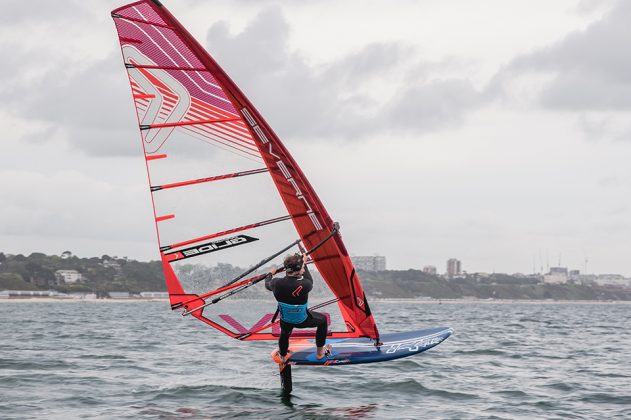You’ve had lift off and you’re hooked! The next question is how do you turn this bucking bronco of a ride into that serene image of cruising along above the water without the thought in the back of your mind that the kit is at any minute going to try and kill you! In other words, how do I get sustained flight and start windsurfing in 3D?
Words Sam Ross // Photo Rolling Rogues
The two challenges that need to be overcome are trim and adjusting ride height of the foil whilst on the move. Trim is about maintaining a flat board from side to side so that the kit doesn’t roll off downwind into a ‘scorpion crash’ or heel hard to windward and go down like a flying squirrel! The next is actively changing the height on the foil to take into account, chop, waves, gusts, lulls and speed.
TRIMMING IT FLAT
Keeping the board flat is accomplished by keeping the windward rail locked down and both rider and rig on top of the board. Try adapting your stance by looking at these 4 H’s
* Head: Start looking upwind to spot gusts and lulls, this will be crucial as you move on to actively adjusting height.
* Hands: Keep the rig still. You may find having the front hand further forward than usual helps keep the height low. Also an underhand front hand often keeps the rig a little stiller in the beginning.
* Hips: The most important part for foiling. Kink your hips out to give yourself a flat back and upright stance. The more kinked you are at the hips and more upright your body the more control you’ll have over the foil.
* Heels: Lock your back heel down to keep the board from rolling over. You’ll need to do this more as you power up and sheet in. To begin with you can keep this foot flat on the board, but as you sheet in you’ll need to drive harder through the back heel.
* Try and keep your legs pretty locked so you maintain constant pressure in the foil. We no longer need to flex our knees over chop and swell.
As you stand more upright and extend your legs you’ll need to adjust your kit. Boom goes up and try shorter harness lines for best success. I wave sail with an under shoulder height boom and 32” lines, but when getting my first sustained flights I had a head high boom and 26” lines.
RIDE HEIGHT
Once the board is flat side to side, you can start managing ride height on the foil. The general principle is weight forward to reduce height, weight back to increase height. We’ll need less height when we have more power or speed and increase height as power and speed reduce. Let’s examine how we achieve that.
Reducing Height: You’ll need to do these actions when you hit a gust, or start to get too high. As you go faster you’ll also need to adopt this position, as with more speed you create more lift from the foil.
* Head: Head forward towards the mast and pull it down into your front shoulder.
* Hands: The easiest way to initially manage height. Bring the front hand forward and pull down to reduce height on the foil.
* Hips: Push your weight against the front of the harness.
* Heels/Feet: Bring your weight onto the front foot and towards the mast foot.
Increasing Height: To increase ride height, do the following.
* Head: Up and back.
* Hands: Front hand back towards the harness lines.
* Hips: Weight back.
* Heels: Drive down through the back foot and even pump the back leg to help generate more height.
Beyond technique you can also tweak the setup with mast foot position being the most effective form of tuning for power and height control. For more control / ‘less lift’, move it forward, and for increased lift, move it back. The next stage would be to move the straps using the same principle, straps moving forward to reduce lift or back to increase. We can also look at the front wing position. Where the front wing is well forward of the foil mast, the mastfoot will need to start further forward in the track. Where the front wing is close to the mast, the mastfoot will have a starting position further back. All the time we are trying to mirror where the lift is coming from underneath the board with our setup and position on top.
So overall, we’re looking to be more still in the lower halves of our bodies than you would be when normally windsurfing. The rig and body need to be upright and once we have the board trimmed side to side we can actively manage height through shifting weight forward and back. Once we’ve conquered this, it opens the door to more transitions, bigger rigs and going faster or whatever skills you fancy on the foil. For more information, check out the RYA Foiling Book or Sam Ross Flight School on YouTube.
“ Rig and body need to be upright.”

